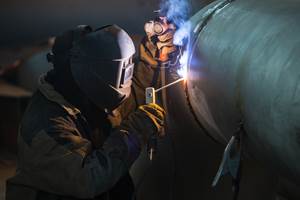The Foundation Of Dimensional Measurement
When getting down to the basics with dimensional measurement, nothing is more basic than that big rock on the shop floor. Actually, the use of rock for the foundation of measurement is relatively new.
When getting down to the basics with dimensional measurement, nothing is more basic than that big rock on the shop floor.
Actually, the use of rock for the foundation of measurement is relatively new. Until World War II, iron was used for creating a flat surface. During the war, iron was hard to find, which created the need for a flat substitute. The first granite surface plate was created. Granite plates were an improvement over iron plates in that they didn’t rust, corrode or warp. If struck accidentally, there were no “nicking and humping” issues for which to compensate. Granite also provides longer life and has a smaller coefficient of thermal expansion. Thus, the shortage of iron created a new industry.
In order to manufacture a surface plate out of stone, its flatness must be determined. From this need arose gages such as the Planekator, Repeat-O-Meter, electronic levels and optics for use with lasers—all for checking and eventually mapping surface plate flatness.
Flatness and repeatability are two specifications that help define the accuracy of a surface plate. A common specification used by manufacturers is GGG-P-463c (granite surface plates). A new specification, ASME B-89.3.7, which incorporates most of the elements of the GGG standard, will soon be published.
Flatness means that all points on the surface will fall between two parallel planes, separated by the flatness tolerance. As with a dial indicator, this can be thought of as a TIR. The highest and lowest points are found, with the difference not exceeding the flatness specification. Three grades for surface plates as defined in the specification are:
- Laboratory grade AA: (40 + diagonal [in inches] of surface plate squared / 25) × 0.000001 inches.
- Inspection grade A: Laboratory Grade AA × 2
- Inspection grade B: Laboratory Grade AA × 4
Some specifications may be expressed as “unilateral” or “bilateral” tolerances, but they mean the same thing. For example, one plate may be labeled with a total deviation of 200 microinches, while another may be labeled ±100 micro inches.
While overall flatness is crucial, it’s also important to avoid having all the flatness variation occur in one localized spot. At this point, a repeatability test simulates placing a height gage, gage block or part on the surface plate. You wouldn’t want a large variation in the plate “tipping” the height gage. This small variation gets magnified the farther away from the plate one measures. Large errors could be seen with a 40-inch height gage, so this specification is much tighter than the flatness specification.
To ensure that there are no local variations that exceed the repeatability specification, a gage is zeroed on the center of the plate and then slid over the plate. For a plate with a diagonal measurement of 30 to 60 inches, the specification of repeat is:
- Laboratory grade AA: 45 microinche
- Inspection grade A: 70 microinches
- Toolroom grade B: 120 microinches
Another issue worth considering is the material of the rock itself. Based on local conditions, granite can have varying degrees of quartz content, with percentages ranging from 22 percent to 32 percent. Less quartz may mean less wear resistance; a little more may translate to a stiffer plate, which could result in a thinner plate with less weight.
Discussing these differences with the manufacturer will provide the best plate for the application. You should also consider this as a long-term purchase. The choice you make in a granite plate is likely to be a legacy that will long be remembered.
Related Content
Selecting The Right Welder
Many machine shops, on occasion, have a need for welding. It may be for maintenance purposes, repair or to fill the odd contract. This story is a welding process primer for those shops whose main business isn't welding but need to know some basics.
Read MoreA New Milling 101: Milling Forces and Formulas
The forces involved in the milling process can be quantified, thus allowing mathematical tools to predict and control these forces. Formulas for calculating these forces accurately make it possible to optimize the quality of milling operations.
Read MoreKey CNC Concept No. 1—The Fundamentals Of Computer Numerical Control
Though the thrust of this presentation is to teach you CNC usage, it helps to understand why these sophisticated machines are so important. Here are but a few of the more important benefits offered by CNC equipment.
Read More6 Steps to Take Before Creating a CNC Program
Any time saved by skipping preparation for programming can be easily lost when the program makes it to the machine. Follow these steps to ensure success.
Read MoreRead Next
The Cut Scene: The Finer Details of Large-Format Machining
Small details and features can have an outsized impact on large parts, such as Barbco’s collapsible utility drill head.
Read More3 Mistakes That Cause CNC Programs to Fail
Despite enhancements to manufacturing technology, there are still issues today that can cause programs to fail. These failures can cause lost time, scrapped parts, damaged machines and even injured operators.
Read More









.png;maxWidth=300;quality=90)













